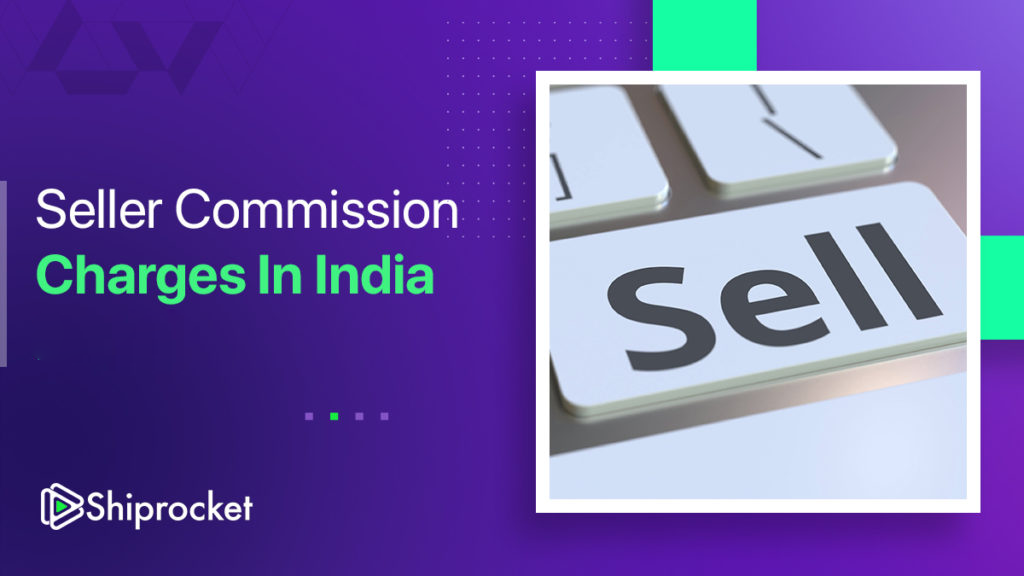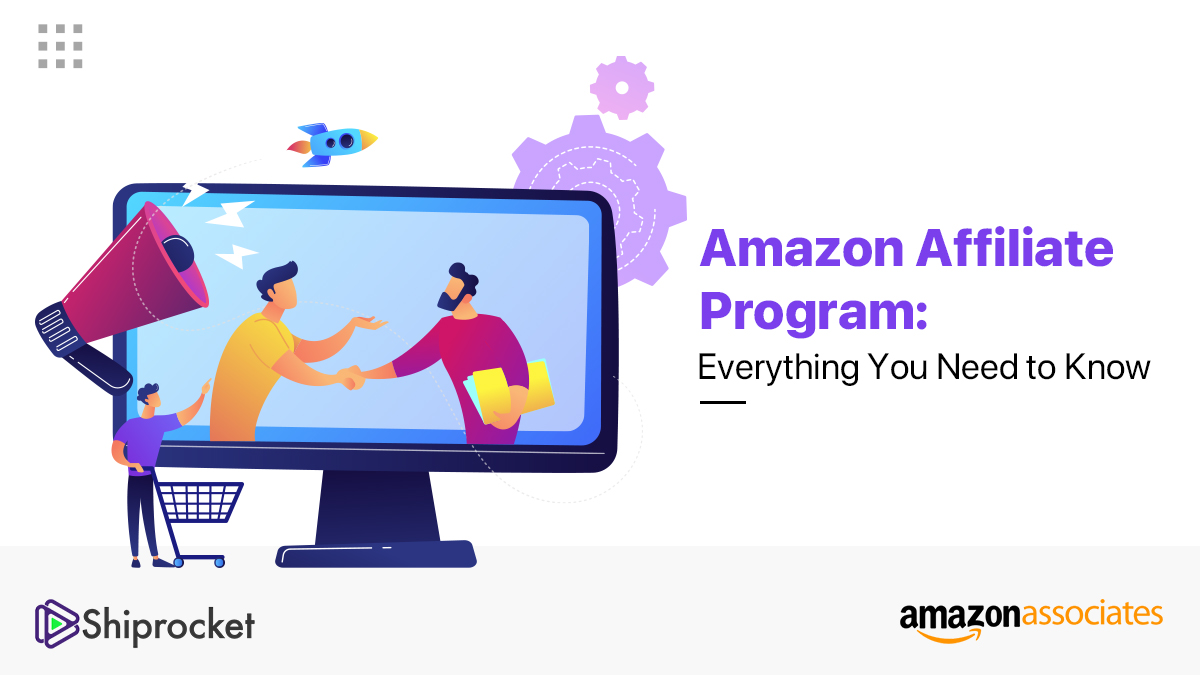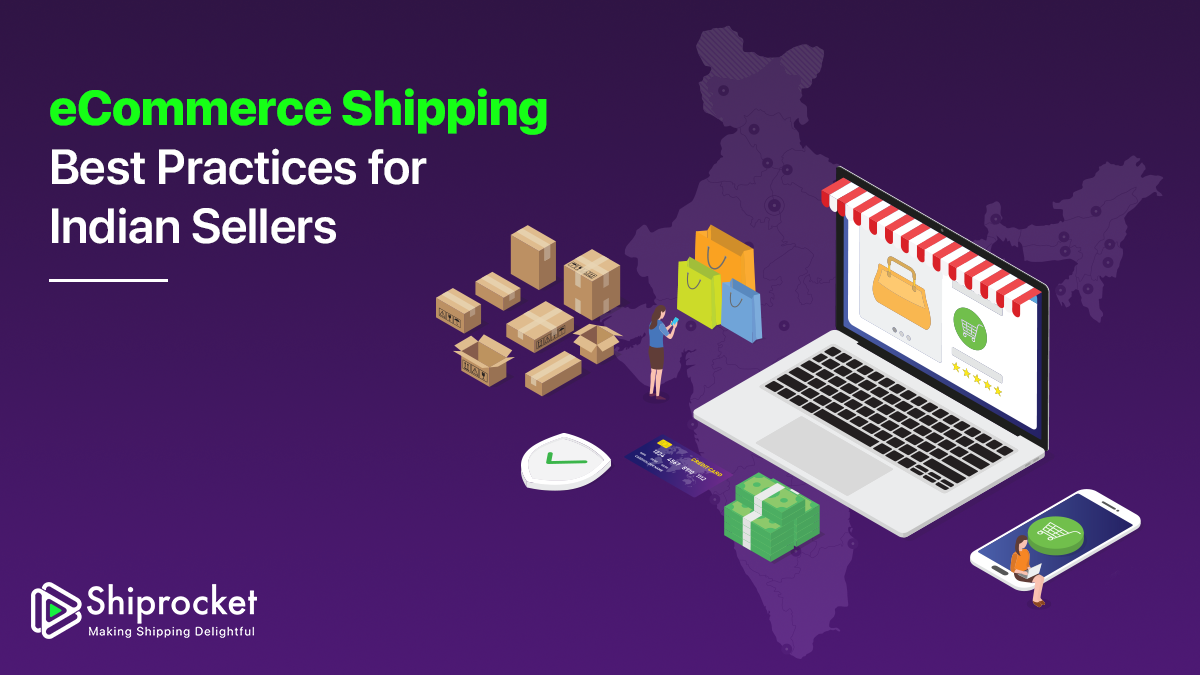Minimum Order Quantity (MOQ): Meaning, Importance & More
If you’re in the eCommerce space for some time now, you must have come across the term Minimum Order Quantity. While some businesses like the concept, some don’t, as it comes with some restrictions on the inventory quantity. In this article, we will talk in detail about what is minimum order quantity and how you can define it for your eCommerce store.
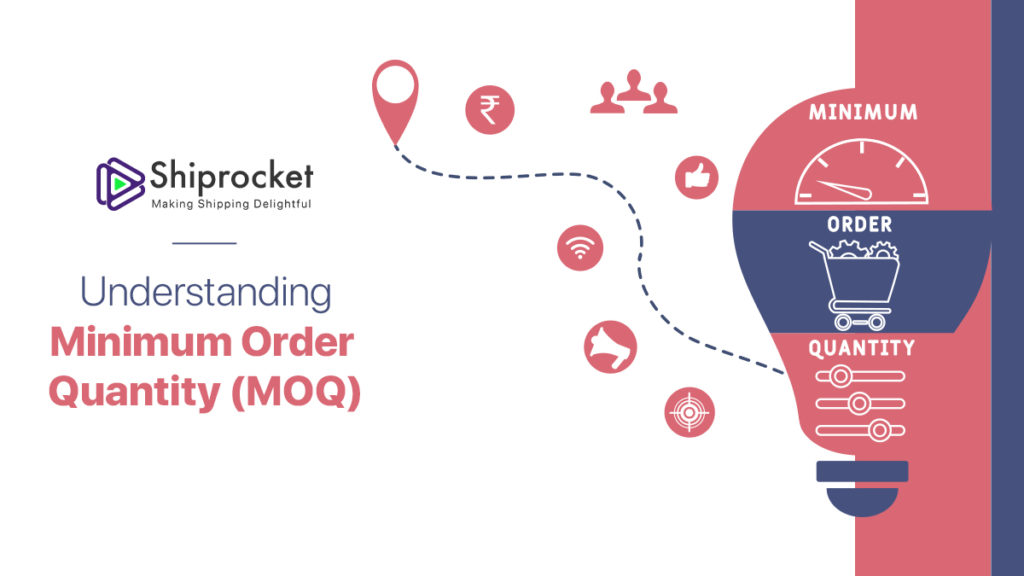
What is Minimum Order Quantity?
Minimum order quantity or MOQ is defined as the least amount of stock one can order from a supplier or the lowest stock the supplier is willing to sell. If you cannot purchase the minimum order quantity of an item you need, the supplier won’t sell it to you.
MOQs vary depending on the type of product. Precious items that cost more to produce typically have lower MOQs, while lower value items that are cheaper to produce have higher MOQs. In the former case, your supplier can make a profit by selling a smaller quantity of the article, whereas in the latter case, suppliers will be counting on the number of items you purchase from them to make a profit. Thus you would need to buy more in number from them.
What Determines the Value of a MOQ?
The concept of MOQs is essential to help manufacturers or businesses. Two factors go into the determination of a MOQ. One is the manufacturer, and the other is the cost of production.
The determination of MOQs based on the production cost requires that the manufacturer consider all of the expenses incurred in production, make a per head cost, and calculate the number of goods as are necessary for him to cover his production cost and get him to break even. Then his MOQ can be set to this figure.
For instance, if a manufacturer of toys incurs an average price of Rs. 50 per pack of small cars, but requires Rs. 500 to get his machinery working, pay labor, pay for distribution, and other fixed costs that he will necessarily incur regardless of the quantity he is producing. His MOQ will be set at 10 packs to ensure he at least breaks even.
MOQs are very important to guide manufacturers in making decisions to ensure that they only take good orders.
Types of MOQs
MOQs, or Minimum Order Quantities, reflect the costs suppliers face when processing an order. These can include expenses for materials, machinery, shipping, and administrative tasks like bookkeeping and billing.
There are two main types of MOQs:
- Simple MOQs
Simple MOQs have just one lower limit, which could be based on either a rupees amount or the number of units (sometimes called “eaches”). Many companies, especially those that aren’t retailers, deal with simple MOQs. For example, a candle manufacturer might require a minimum number of candles to be ordered. The cost of setting up the moulds, preparing the wax, and running the production wouldn’t be feasible for just a few candles, so they set a minimum order size to ensure profitability.
- Complex MOQs
Complex MOQs involve multiple requirements. For instance, a custom furniture maker might not just have a minimum order for the number of pieces. They could also have additional requirements like a minimum amount of wood of a certain type, a minimum order value, and specific design elements that need to be ordered in bulk. All these conditions must be met for an order to be accepted.
Importance of Minimum Order Quantity
Minimum order quantity is equally essential for both the supplier and the retailer or buyer who is purchasing the stock from the supplier. Suppliers set a minimum order quantity after considering the total cost of the inventory and other expenses incurred while sourcing the items. Choosing MOQs correctly helps suppliers in increasing their profits while selling off the inventory quickly.
For buyers or retailers, MOQs play a crucial role in getting the best price possible for each unit. This happens when the retailer purchases items in bulk from the supplier because bulk purchases always lower the per-unit cost, allowing them to maximize profits while selling each unit.
However, remember that when you buy the MOQ from your supplier, you will be investing a good amount in inventory alone. So, you need to ensure that you have the capital to seek credit for the entire quantity. Plus, you will also need money for day-to-day operations. For example, it costs you Rs. 20 each for an MOQ of 1000 units. This means you have to pay an upfront cost of Rs. 20,000 for the stock alone. In addition to this, you will need to spend on other aspects like shipping, warehousing, and so on.
How Does MOQ Affect Inventory?
Minimum Order Quantities (MOQs) can have a big impact on inventory for both sellers and buyers. Sellers with a high MOQ need to produce and store large amounts of products, which affects how they manage their inventory.
- High Minimum Order Quantity (MOQ)
When suppliers have a high MOQ, they often need to keep a lot of inventory ready to fill orders. If they prefer to keep less inventory and use just-in-time management, they might need longer lead times to get orders out. Having more inventory ties up money and takes up storage space, but it can save on administrative costs because they order less often, which might also lead to savings when buying in bulk. This reduces the risk of going out of stock but increases the chance of products becoming outdated, especially for items like electronics.
- Low Minimum Order Quantity (MOQ)
With a low MOQ, suppliers don’t need as much inventory on hand since orders are usually smaller. This means less inventory and faster turnover. However, the sales team might need to work harder to find more customers and keep sales up. Low MOQs also mean more frequent ordering, which can increase administrative costs. There’s a higher chance of running out of stock, but the risk of items becoming outdated is lower.
Benefits of Minimum Order Quantity (MOQ)
Minimum Order Quantities (MOQs) can bring several benefits to both suppliers and buyers. When used effectively, MOQs can help control inventory, reduce costs for buyers, and maintain healthy profit margins for suppliers.
Benefits for Suppliers
- Improved Cash Flow: By setting the right product prices and order sizes, MOQs can help suppliers have a more predictable and healthier cash flow.
- Lower Inventory Costs: MOQs can help suppliers manage inventory costs. Instead of producing large quantities and then searching for many small buyers, suppliers can wait for buyers who are ready to purchase a profitable amount. This reduces the need for warehouse space and lowers inventory costs.
- Better Profit Margins: With MOQs, suppliers can produce goods only when there’s enough profit to be made, helping them maintain better control over their profit margins.
Benefits for Buyers
- Bulk Savings: Buyers can often get better prices per unit when ordering in bulk through suppliers with MOQs. Even if it means higher warehousing costs or having to sell items at a discount to move them faster, the savings from bulk purchases can increase overall profits.
- Improved Supplier Relationships: Building a strong relationship with suppliers is key. Understanding the balance between a buyer’s ideal order size (Economic Order Quantity or EOQ) and the supplier’s MOQ is important. If the MOQ is higher than the EOQ, buyers can sometimes negotiate with suppliers for solutions, like splitting orders with other buyers.
How to Calculate Minimum Order Quantity?
There’s no one-size-fits-all MOQ (Minimum Order Quantity) because each business has different needs. Generally, businesses face a tradeoff: they can pay a higher per unit price for a lower MOQ or set a higher MOQ at a lower price. You may not come across a fixed formula, but here are four steps to help you figure out your MOQ.
1. Estimate Demand
The first thing a supplier and merchant need to do before the supplier actually produces the inventory and the merchant buys it is to understand and evaluate how much stock they want to sell. This phenomenon is known as demand forecasting, and it’s done best with competition, product type, seasonality, and other factors in mind. It gives you an estimate of how many units both parties will sell, which can help determine your next purchase order.
For example, if your forecast says you’ll sell 900 units next quarter, and your supplier’s MOQ is 1,000 units, the difference of 100 units might not be a big deal. Especially if the product is small, like keychains, the extra stock can serve as a backup in case demand increases unexpectedly.
But, if your forecast says you’ll sell only 400 units, and your supplier’s MOQ is 1,000 units, you might need to negotiate for a lower MOQ that better fits your needs.
2. Reach Your Break-even Point
To set an MOQ, both suppliers and merchants need to know their break-even point—the price at which they neither make a profit nor a loss. Suppliers set their MOQ above this price to ensure profitability.
For instance, if it costs a supplier ₹30 to make a product, the break-even point is ₹30. If an ecommerce business spends ₹8,000 to buy 200 units from the supplier, its break-even point is ₹40 per unit.
3. Understand Your Holding Costs
Some products can be a little more expensive to store as compared to others, due to their size, storage duration required, and special warehousing needs. You’ll be in a better place financially if you don’t keep such items in your stock for long.
Understanding these holding costs, the expenses incurred to store products in a warehouse, helps you avoid overstocking and the financial strain of excess inventory. This is the reason that suppliers might wait for orders before producing or storing goods, and merchants should be cautious of high MOQs.
4. Set Up Your MOQ
After collecting all that information, you’re now ready as a supplier or merchant to allocate an MOQ. Now, let’s say:
- Your brand expects to sell 500 units next quarter.
- Your break-even point is ₹300 per unit.
- It costs ₹50 per unit per quarter to store your product.
- If you stock the 500 units you plan to sell, it will cost you ₹1,75,000 in total. To make a profit, you’ll need to price each unit above ₹350. The exact pricing will influence your MOQ.
For instance, if you price each unit at ₹450, you’ll need to sell at least 390 units to break even, so setting an MOQ of 400 units will help ensure profit.
Alternatively, if you price each unit at ₹600, you’ll only need to sell around 292 units to make a profit, so your MOQ could be lower, around 300 units, ensuring profitability even with fewer sales.
How to Deal with MOQs as a Buyer or Retailer
As a retailer, you need to present yourself as the ideal customer to your supplier while ensuring that the deal is beneficial. Let us take a look at how to deal with MOQs as a retailer –
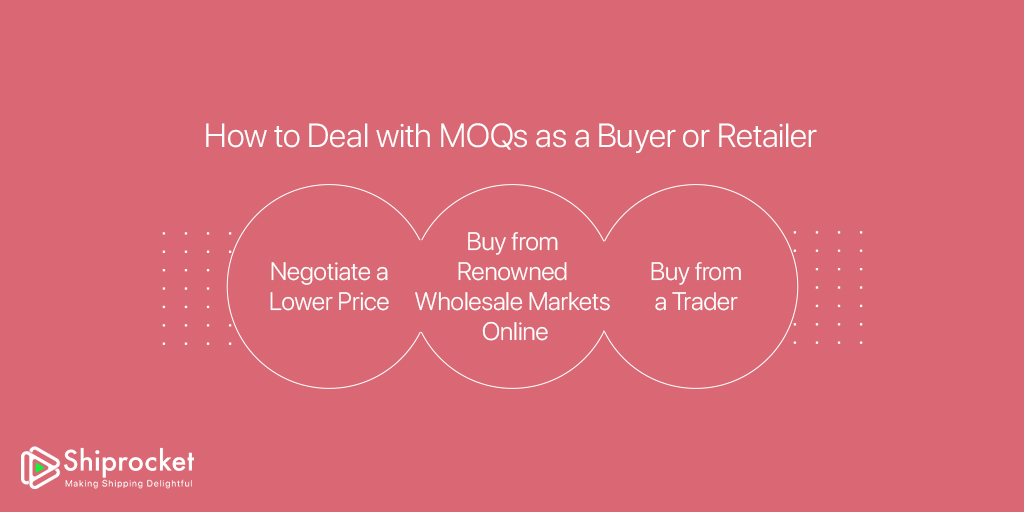
- Negotiate a Lower Price
Attempt to negotiate a lower price if you want to make MOQs worth it. Do not assume that the price being offered can’t be lowered, as there is always room for negotiation. Even if you are unsuccessful in the first negotiation attempt, revisit the pricing after developing a good relationship with your supplier. Likewise, you can convince your supplier to offer lower prices to you when they’re having a lean period or excess stockpiling.
However, if the supplier you’re approaching is in high demand with other loyal customers, it will be challenging to get a deal. In such a case, if you want the items badly but don’t want the full minimum quantity, the best course of action for you would be to pay more and receive less.
- Buy from Renowned Wholesale Markets Online
Online marketplaces such as Alibaba, IndiaMart, etc., will help you source products from a large variety of suppliers, thus allowing you to compare prices and deals that best suit your business needs. One essential thing you must keep in mind while choosing suppliers from marketplaces is, even though the marketplace may have vetted them, you must assess the suppliers independently. It will be wise not to go by reviews alone and to run your checks.
The primary benefit of buying from online B2B marketplaces is that you get a wider pool of vendors or suppliers offering the same product with multiple price ranges for you to choose from.
- Cut Out Slow-Moving SKUs
Many brands end up with more SKUs (Stock Keeping Units) than they actually need, which means spending extra money on storage and meeting MOQs for items that don’t sell well or generate revenue.
Keeping your SKU count simple and minimal makes it easier to manage inventory. For example, managing 10 SKUs is much easier than juggling 30 or even 300. It’s common to overestimate how much customers will like new colors or slight product variations. Often, offering more than three choices can overwhelm shoppers in an online store. No matter how many SKUs you have, it’s important to keep track of their performance.
- Buy from a Trader
Getting a trading company to place an order for your inventory can also work out for you.
Because trading companies can place one order for multiple retailers, they can meet the supplier’s MOQ without you having to stretch your budget or take the whole inventory. So, various retailers can enjoy the benefits of a lower-priced MOQ and holding just as much stock as they need by buying through traders.
Final Say
You may be tempted to try to lower your supplier’s MOQs as much as possible. And while some suppliers go as low as they can, know that you may have to deal with some issues. Very low MOQs may force suppliers to produce and provide low-quality goods so that they can maintain profits. This is likely to make your products less durable and hence affect your earnings.
It’s essential to keep in mind that MOQs is just one of the many considerations you have to make. Factoring in your inventory turnover rate is also just as crucial to helping you manage your inventory smoothly.



